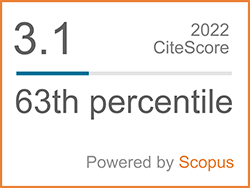Investigations on Agrophotovoltaic System Using Different Crops with Special Attention on the Improved Electrical Output
Abstract
Keywords
[1] S. V. Deshmukh, S. S. Joshi, A.V. Khapekar, and M. Y. Mohite, “Theoretical and experimental investigations on the performance of passive cooling arrangement for solar photovoltaic module,” Journal of the Brazilian Society of Mechanical Sciences and Engineering, vol. 45, 2023, Art. no. 32, doi: 10.1007/s40430-022- 03964-3.
[2] IRENA, “Future of solar photovoltaic: Deployment, investment, technology, grid integration and socio-economic aspects,” International Renewable Energy Agency, Abu Dhabi, 2019.
[3] M. Trommsdorff, I. S. Dhal, Ö. E. Özdemir, D. Ketzer, N. Weinberger, and C. Rösch, “Chapter 5 - Agrivoltaics: Solar power generation and food production,” in Solar Energy Advancements in Agriculture and Food Production Systems. Massachusett: Academic Press, 2022, doi: 10.1016/B978-0-323-89866-9.00012-2.
[4] D. Majumdar and M. J. Pasqualetti, “Dual use of agricultural land: Introducing ‘agrivoltaics’ in Phoenix Metropolitan Statistical Area, USA”, Landscape and Urban Planning, vol. 170, pp. 150–168, 2018, doi: 10.1016/j.landurbplan. 2017.10.011
[5] M. Abdullah, D. Paul, D. Wadley, N. A. Zulkarnain, and A. Aziz, “A review of research on agrivoltaic systems,” Renewable and Sustainable Energy Reviews, vol. 161, 2022, doi: 10.1016/j.rser. 2022.112351.
[6] A. Weselek, A. Ehmann, S. Zikeli, I. Lewandowski, S. Schindele, and P. Högy, “Agrophotovoltaic systems: Applications, challenges, and opportunities. A review.” Agronomy for Sustainable Development, vol. 39, 2019, doi: 10.1007/s13593-019-0581-3.
[7] A. Armstrong, N. Ostle, and J. Whitaker, “Solar park microclimate and vegetation management effects on grassland carbon cycling,” Environmental Research Letters, vol. 11, 2016, doi: 10.1088/1748-9326/11/7/074016.
[8] N. Brisson, C. Gary, E. Justes, R. Roche, B. Mary, D. Ripoche, D. Zimmer, J. Sierra, P. Bertuzzi, P. Burger, F. Bussière, Y. M. Cabidoche, P. Cellier, P. Debaeke, J. Gaudillère, C. Hénault, F. Maraux, B. Seguin, and H. Sinoquet, “An overview of the crop model stics,” European Journal of Agronomy, vol. 18, no. 3–4, pp. 309–332, 2003, doi: 10.1016/S1161-0301(02)00110-7.
[9] U. Jamil, A. Bonnington, and J. Pearce, “The agrivoltaic potential of Canada,” Sustainability, vol. 15, no. 4, 2023, doi: org/10.3390/su15043228.
[10] P. Campana, B. Stridh, S. Amaducci, and M. Colauzzi, “Optimisation of vertically mounted agrivoltaic systems,” Journal of Cleaner Production, vol. 325, 2021, doi:10.1016/j.jclepro. 2021.129091.
[11] Y. Elamri, B. Cheviron, J. Lopez, C. Dejean, and G. Belaud, “Water budget and crop modelling for agrivoltaic systems: Application to irrigated lettuces,” Agricultural Water Management, vol. 208, pp. 440–453, 2018, doi:10.1016/ j.agwat.2018.07.001.
[12] F. Johansson, B. Gustafsson, B. Stridh, and P. Campana, “3D-thermal modelling of a bifacial agrivoltaic system: A photovoltaic module perspective,” Energy Nexus, vol. 5, 2022, doi:10.1016/j.nexus.2022.100052.
[13] M. Wagner, J. Lask, A. Kiesel, I. Lewandowski, A. Weselek, P. Högy, M. Trommsdorff, M. Schnaiker, and A. Bauerle, “Agrivoltaics: The environmental impacts of combining food crop cultivation and solar energy generation,” Agronomy, vol. 13, no. 299, 2023, doi: 10.3390/ agronomy13020299.
[14] H. Alam, M. Alam, and N. Butt, “Techno economic modeling for agrivoltaics: Can agrivoltaics be more profitable than ground mounted PV?,” Journal of Photovoltaics, 2022, doi:10.48550/ arXiv.2206.05964.
[15] D. Harshavardhan and J. Pearce, “The potential of agrivoltaic systems,” Renewable and Sustainable Energy Reviews, vol. 54, pp. 299–308, 2016, doi: 10.1016/j.rser.2015.10.024ff.ffhal-02113575f.
[16] E. Fernández, A. Fernández, J. Romero, L. Torres, P. Rodrigo, A. Manzaneda, and F. Almonacid, “Global energy assessment of the potential of photovoltaics for greenhouse farming,” Applied Energy, vol. 309, 2022, Art. no. 118474, doi: 10.1016/j.apenergy.2021.118474.
[17] O. Katsikogiannis, H. Ziar, and O. Isabella, “Integration of bifacial photovoltaics in agrivoltaic systems: A synergistic design approach,” Applied Energy, vol. 309, 2022, Art. no. 118475, doi: 10.1016/j.apenergy.2021.118475.
[18] R. Waghmare, R. Jilte, and S. Joshi, “Review on agrophotovoltaic systems with a premise on thermal management of photovoltaic modules therein,” Environmental Science and Pollution Research, vol. 30, no. 10, 2022. doi: 10.1007/ s11356-022-23202-6.
[19] Y. Araki, S. Inoue, and K. Murakami, “Effect of shading on growth and quality of summer spinach,” International Society for Horticultural Science, vol. 483, pp. 105–110, 1999, doi: 10.17660/ActaHortic.1999.483.10.
[20] A. Cossu, L. Murgia, L. Ledda, P. Deligios, A. Sirigu, F. Chessa, and A. Pazzona, “Solar radiation distribution inside a greenhouse with south-oriented photovoltaic roofs and effects on crop productivity,” Applied Energy, vol. 133, pp. 89–100, 2014, doi: 10.1016/j.apenergy. 2014.07.070.
[21] H. Jo, S. Asekova, M. Bayat, L. Ali, J. Song, Y. Ha, D. Hong, and J. Lee, “Comparison of yield and yield components of several crops grown under agro-photovoltaic system in Korea,” Agriculture, vol. 12, no. 619, 2022, doi: 10.3390/agriculture 12050619.
[22] G. A. Barron-Gafford, M. A. Pavao-Zuckerman, R. L. Minor, L. F. Sutter, I. Barnett-Moreno, D. T. Blackett, M. Thompson, K. Dimond, A. K. Gerlak, G. P. Nabhan, and J. E. Macknick, “Agrivoltaics provide mutual benefits across the food–energy–water nexus in drylands,” Nature Sustainability, vol. 2, pp. 848–855, 2019, doi: 10.1038/s41893-019-0364-5.
[23] B. Williams, K. Hashad, H. Wang, and K. M. Zhang, “The potential for agrivoltaics to enhance solar farm cooling,” Applied Energy, vol. 332, 2023, Art. no. 120478, doi: 10.1016/j.apenergy.2022. 120478.
DOI: 10.14416/j.asep.2023.09.007
Refbacks
- There are currently no refbacks.






.png)



